Known as the ‘boy king’, Tutankhamun has captured the world’s attention for more than a century, after his tomb was uncovered in 1922.
He is believed to have been one of the youngest leaders in ancient Egyptian history, having taken to the throne at just nine or ten years old.
The pharaoh was also just 19 when he died more than 3,300 years ago, with his burial site located at the world-famous Valley of the Kings.
Yet, Tutankhamun’s life is enveloped in mystery, with looming uncertainty surrounding his cause of death, the contents of his tomb and even his iconic mask.
As archaeologists continue piecing together his life, MailOnline has compiled a list of the five most puzzling questions about the boy king.
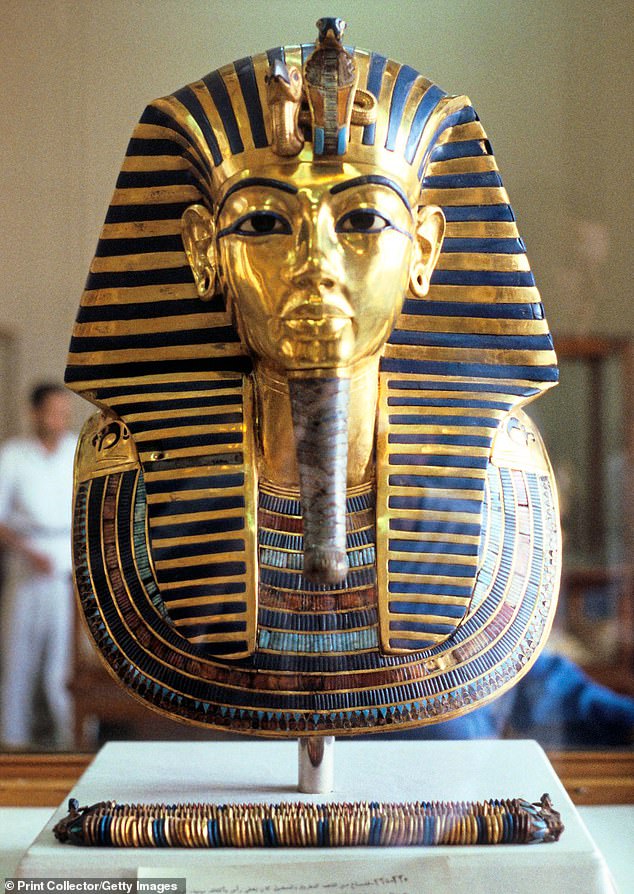
Tutankhamun is believed to have been one of the youngest leaders in ancient Egyptian history having taken to the throne at just nine or ten years old
How did Tutankhamun die?
Mystery has always surrounded the death of Tutankhamun, who passed away at just 19 years old.
Many have speculated that the young pharaoh was murdered, with a bump on his head indicating that he may have been hit from behind.
But in 2005 no evidence of this was found, as leading Egyptologist Dr Zahi Hawass announced the damage to his head actually came about during the mummification process.
It was just five years later when experts instead came to the belief that the Egyptian leader may have actually died from a broken leg.
As part of a study published by the Journal of the American Medical Association (AMA), the pharaoh’s mummy was radiologically examined to determine his cause of death.
Experts concluded Tutankhamun was a very fragile leader with multiple disorders and malaria that may have made an infected broken leg life-threatening.
It was also said that Tutankhamun needed a cane to walk as he had the painful Köhler disease in addition to oligodactyly in his right foot and clubfoot on his left.
Fruits and seeds found in his tomb also indicated that he was receiving medical treatment, the scientists added.
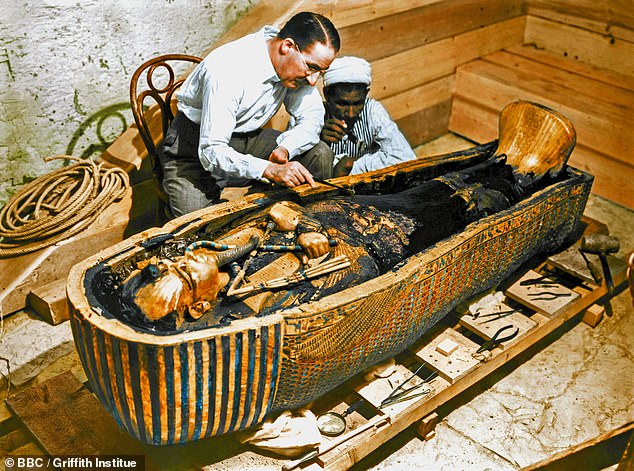
Pictured: Howard Carter and a colleague cleaning the coffin of young Pharaoh Tutankhamun
Is there more to find Tutankhamun’s tomb?
The Valley of Kings
The Valley of the Kings in upper Egypt is one of the main tourist attractions of the country, next to the Giza pyramid complex.
The majority of the pharaohs of the 18th to 20th dynasties, who ruled from 1550 to 1069 BC, rested in the tombs which were cut into the local rock.
The most famous pharaoh at the site is Tutankhamen, whose tomb was discovered in 1922.
Preserved to this day, in the tomb are original decorations of sacred imagery from, among others, the Book of Gates or the Book of Caverns.
These are among the most important funeral texts found on the walls of ancient Egyptian tombs.
It has been more than a century since archaeologist Howard Carter first discovered Tutankhamun’s tomb, where over 5,000 treasures were recovered.
Yet, excavation work still continues to this day as many believe the tomb has more secrets to reveal.
Last year, fellow archaeologist Dr Nicholas Reeves suggested that Tutankhamun’s tomb is only an antechamber of a much bigger structure.
He said that a larger sepulchre may be hidden behind it – leading to the resting place of Tutankhamun’s stepmother, Queen Nefertiti.
Dr Reeves told The Times: ‘The greatest archaeological discovery in the world has got more to give – potentially something far more impressive than Tutankhamun’s burial.
‘I’m suggesting that the most famous woman in the ancient world is also buried there.’
Nefertiti, believed to be Tut’s stepmother, ruled over what some scholars say was the wealthiest period of ancient Egypt, where the empire flourished, in the 14th century BC.
If correct, the items buried with Nefertiti will have remained completely untouched since her burial.
This differs to the initial exploration of Tutankhamun’s tomb where more than half of the royal jewellery had already been stolen.
However, it still took Carter more than 10 years to document all the treasures that remained buried with him.
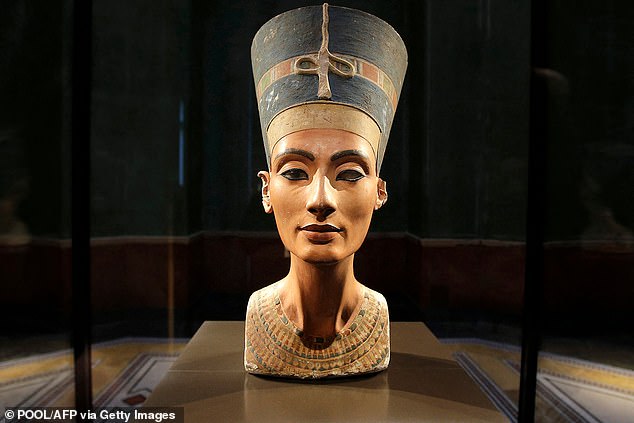
Nefertiti, believed to be Tut’s stepmother, ruled over what some scholars say was the wealthiest period of ancient Egypt, where the empire flourished, in the 14th century BC
Who else might be buried in Tutankhamun’s tomb?
Despite Dr Reeves beliefs, some have previously speculated that it might not be Queen Nefertiti who is buried behind Tut’s tomb.
In 2015, the former Egyptian Minister of Antiquities, Mamdouh Eldamaty, suggested that a hidden chamber could instead belong to the pharaoh’s mother Queen Kiya.
Little is known about Queen Kiya, but she is believed to have been one of the wives of Egyptian Pharaoh Akhenaten.
The minister claimed that Neferetiti was actually dead once Tut came to power and also asserted that it would have been ‘ideal’ for him to be buried with his mother, according to Ahram Online.
Yet some have disputed that secret chambers even exist, with experts claiming that radar surveys used as evidence do not prove anything.
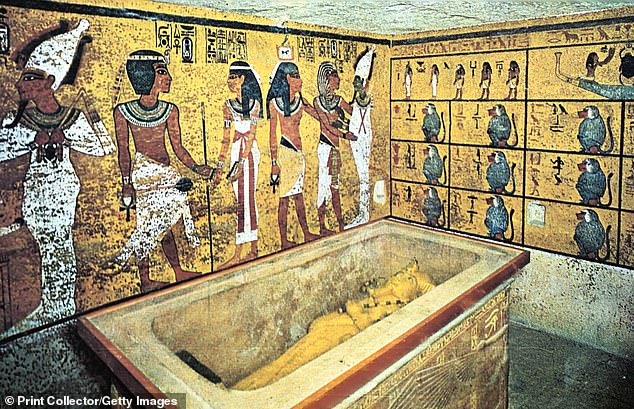
Pictured: Sarcophagus containing the coffin of Pharaoh Tutankhamun which held his mummy
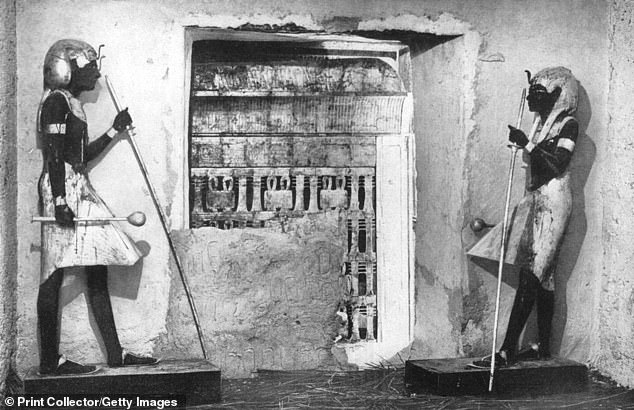
The first glimpse of Tutankhamun’s tomb, when uncovered during 1922 (pictured)

Some experts believe Tutankhamun’s tomb was in fact Nefertiti’s, and when the boy king died unexpectedly at a young age, he was rushed into her tomb’s outer chamber in Luxor’s Valley of Kings
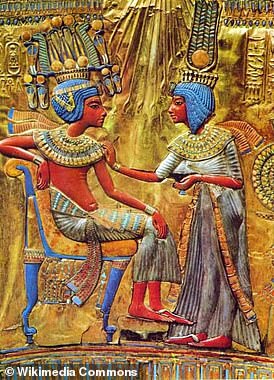
Ankhesenamun wears a white shawl as she attends her husband and half-brother King Tutankhamun, who is sitting on a chair
Sources: Britannica.com, Daily Mail and Telegraph.
In 2016, the Director of the Egyptian Museum, Friederike Seyfried, said that it was only a hypothesis to believe that a queen is hidden in the chamber.
She told Ahram Online: ‘The sudden death of the boy-king led the tomb’s builders to finish the tomb quickly and close it up, which is why a cavity was found.’
As a result of these clashing opinions, several international Tutankhamun conferences have been held on a yearly basis, attempting to discover what really went on.
Ms Seyfried’s thoughts were eventually backed up by a 2018 statement which claimed with a ‘high level of confidence’ that no hidden chamber existed, according to National Geographic.
The statement, released on behalf of Mostafa Waziri, Secretary General of the Supreme Council of Antiquities, read: ‘We conclude, with a very high level of confidence, that the hypothesis concerning the existence of hidden chambers adjacent [to] Tutankhamun’s tomb is not supported by the GPR data.’
Yet, new research on hieroglyphs has opened up the door to this mystery all over again.
Dr Reeves has since re-emphasised that the odds of Nefertiti lying behind Tut’s burial place are now slightly better than 50/50.
What happened to Tutankhamun’s wife?
For a long time, Tut’s wife, Ankhesenamun, has remained a mystery to scientists having disappeared from records somewhere between 1325 and 1321 BC.
But in 2010, experts edged closer to solving the case once and for all following DNA tests performed on two mummies found in the Valley of Kings.
One of the bodies was shown to be the mother of twins found in Tut’s tomb, suggesting it was Ankhesenamun.
However, doubt was cast on her identity as scientists discovered that the other mummy was not her father, Akhenaten.
In another turn of events, Dr, Zahi Hawass uncovered a new burial chamber in the Valley of Kings during 2017 which could instead belong to Ankhesenamun.
Experts were drawn to the site after foundation deposits, caches of pottery, food remains and other tools were found, suggesting the presence of a burial chamber.
As a result, 100 Egyptian workers took to excavating the untouched Valley of Kings area located near the tomb of pharaoh Ay.
Ankhesenamun, married to Tutankhamun, was wed with Ay after Tutankhamun’s sudden death.
Ay ruled immediately after King Tut, from 1327 to 1323 BC.
It is still uncertain where her body remains.

In 2017, experts edged closer to solving the case once and for all having uncovered a new burial chamber in the Valley of Kings
Was Tutankhamun’s mask made for him?
Tutankhamun’s iconic gold funeral mask is one of the most famous artefacts of all time, cleverly crafted by hammering two sheets of gold together.
But some suggest that it was not actually designed for the boy king and instead was made for a woman.
In 2016, Dr Yasmin El Shazly, an Egyptologist, claimed that the golden death mask may have originally depicted a female pharaoh before it was fitted to Tut.
The expert explained that the face was originally separate from the headdress before they were welded together.
This two-piece mask differs from typical pharaoh death masks which are usually made in one piece.
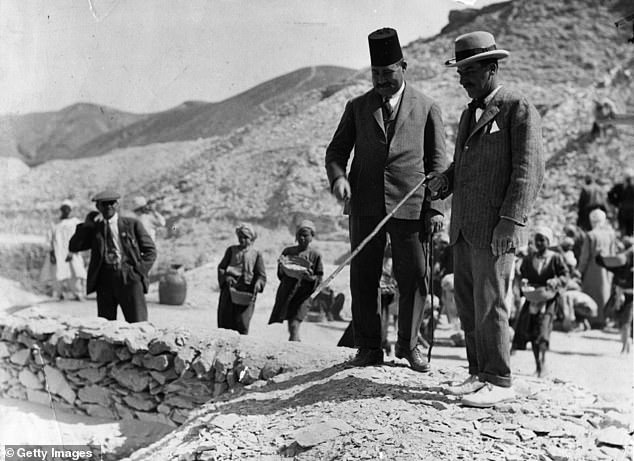
British archaeologist Howard Carter (1874 – 1939) at Tutankhamun’s tomb, March 1 1923
She also explained the ears of the mask were originally pierced, which was unusual for a 3D depiction of a man.
‘It suggests the face itself did not originally belong to the rest of the headdress, and that the headdress belonged to a woman,’ she said.
In another twist, Dr El Shazly suggested that Tut’s tomb may not have been made for him either as the room was also scattered with feminine decorations.
For instance, she claimed canopic jars found in the burial chamber were decorated with very feminine faces that look different to depictions of King Tut.
But for now, the mystery remains.
source:dailymail.co.uk








